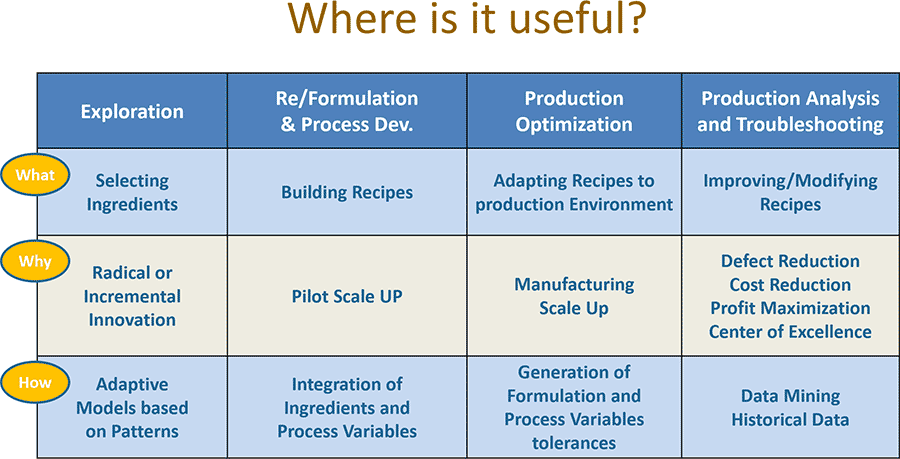Applications

Produce a new polyurethane foam formulation.
- 15 properties (targets)
- 62 combinations of ingredients consisting of
- 16 Polyols
- 8 functions
- 8 grafts
- 9 Chain extenders
- 4 isotopes
- Water
- Where:
- A minimum of 1 to a maximum of 7 polyols can be present
- Of those polyols, a maximum of 2 functions can be present
- Of those polyols, a maximum of 2 grafts type can be present
- A minimum of 1 to a maximum of 3 chain extenders can be present
- Only I Isotope can be present
- Water is always present
- 120 labs experiments
- 2 formulations identified
Develop a new thermoplastic elastomer (TPE) product, to replace rubber and PVC. After 2 ½ years still can’t attain the objectives of hardness, abrasion and gloss simultaneously.
- 10 properties (targets).
- 14 variables including ingredients and process variables.
- 2 sets of interchangeable variables.
- 3 variables that can be used in 3 combinations.
- 2 variables conditional to other variables.
- Uneven interval values ranging from 2 to 14.
- 21 constraints.
- 12 different ways (paths) to solve the problem.
- 3 iterations.
- 44 experiments.
Compound a main ingredient available in various hardness properties with other materials to develop a series of products with different hardness properties.
- 2 properties (targets).
- 5 ingredients variables.
- 3 variables of which only one must be used at any given time.
- 7 constraints.
- 2 different ways (paths) to solve the problem.
- 25 experiments.
- 3 iterations.
- 17 products were developed.
Quality of product made with an extrusion process for over 25 years had been more and more difficult to maintain over time where it became difficult to meet production targets without growing levels of reject and cost.
- 15 properties (targets).
- 37 variables including ingredients and process variables.
- 4 constraints.
- Used data accumulated by customer over time.
- 1 iteration, where we used existing variable ranges.
- 1 iteration where we used possible variable ranges.
- 1 iteration where we used revised variable ranges.
- No experiment required.
Poor flow of material during compaction and compression causing Picking and Capping, increasing rate of reject; corrected by reduction of press speed, leading to loss of revenue. No solution in sight after running more than 200 experiments.
- 5 properties (targets).
- 17 variables including ingredients and process variables.
- 5 variables of which any 2 can be mixed at a time.
- 3 variables that can be used in any combination limited by a maximum weight.
- 2 process variables conditional to manufacturing methods.
- Uneven interval values ranging from 2 to 5.
- 15 constraints.
- 14 different ways (paths) to solve the problem.
- 1 iteration.
- 18 experiments.
Need to reduce the cost of manufacturing a laminated paperboard to avoid losing the business to a competitor.
- 5 properties (targets).
- 9 variables including ingredients and process variables.
- 1 variable conditional to raw material selection.
- Uneven interval values ranging from 2 to 8
- 2 different ways (paths) to solve the problem.
- 2 iterations.
- 19 experiments.
Analyze 6 different processes and 3 different grades of an ingredient to determine impact of each of the 18 combinations on a given property to select the most appropriate combination.
- 1 property (target value)
- 10 variables including ingredients and process variables.
- 6 continuous and 4 discrete variables
- 6 constraints
- 3 iterations.
- 32 experiments.
- 5 combinations produced the expected results.
Design the aerodynamics of a race car to reach objectives of lift, drag and minimum pressure coefficient, while respecting very stringent specifications established by the Society of Automobile Engineers (SAE). This to be done in a very short period of time.
- 3 properties (targets)
- Design and optimize 3 sets of wings, front, middle and rear.
- Optimize aerodynamics of wings and car together.
- Experiments to be run on simulation software using Finite Element analysis (FEA) and Computational Fluid Dynamics (CFD).
- 68 variables (22 continuous and 46 discrete).
- 50 constraints (mainly nonlinear: SIN, COS, TAN).
- 1 month to generate sets of wings.
- 1 month to optimize car.
- 310 experiments.
